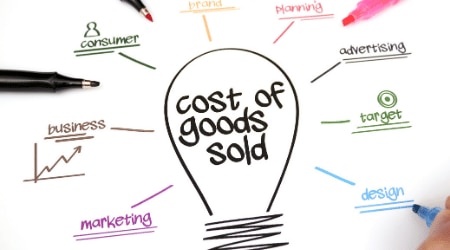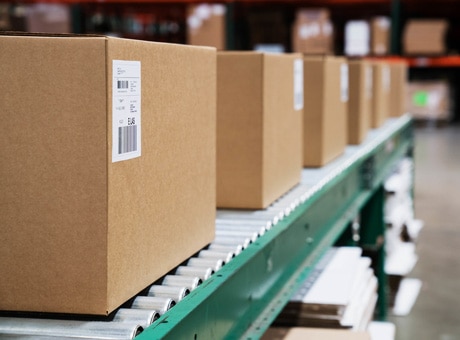The timing of your inventory purchases and sales can have a huge impact on company profits and your tax liability. To understand how inventory impacts a firm’s tax liability, consider the concept of accrual accounting, the issue of inventoriable costs, and inventory valuation methods. You can use this knowledge to project your company profits and calculate the related tax liability.

How Inventory Valuation Drives Profits and Taxes
The Relationship Between Inventory and Accounting
The timing of expenses will impact your company profit, and the tax on that profit. Almost all businesses operate using accrual accounting, which means that revenue is recorded when earned and expenses are posted when incurred. Accrual accounting matches revenue with the expenses incurred to produce the revenue.
Assume, for example, that a restaurant owes employees $3,000 for wages earned in the last week of December 2018. The next payroll pay date is January 5th of 2019. The restaurant incurred $3,000 in payroll expenses to earn revenue during the last week of 2018. Therefore, the $3,000 is a payroll expense in 2018, even though it is not paid until 2019.
This process matches 2018 revenue earned with expenses incurred in 2018. Under accrual accounting, the movement of cash does not drive the accounting entries.
What Are Inventoriable Costs?
Accrual accounting also applies to inventory. When a company sells an item out of inventory, revenue (a sale) is generated, and cost of goods sold is posted to the accounting records. The cost recorded determines the profit on the sale, and the eventual tax on the profit.
Inventoriable costs are expenses that should be included with the merchandise held in inventory. Accountants define inventoriable costs as the cost paid to the supplier, plus all costs incurred to “prepare the inventory for sale”. Freight costs are inventoriable costs, as well as costs incurred to make changes or additions to the items in inventory. As an example, when a retailer adds their brand name or logo to an inventory item, it is an inventoriable cost.
Why the Timing of Expenses Is Important
Imagine walking into a sporting goods store that is carrying $300,000 of inventory. None of those costs have been expensed yet. Instead, those costs remain “attached” to each inventory item until the item is sold. Unlike many other expenses, inventory costs do not become expenses until a sale takes place. So, the recognition of these expenses is delayed.
The matching principle means that sales and cost of sales are incurred in the same time period. If the shop sells $300,000 in inventory at a total sale price of $350,000 in March, for example, the store generates revenue ($350,000), cost of sales ($300,000) and profit of $50,000—all in the same month of March.
In many instances, the value placed on a particular inventory item will be different, depending on when the item was purchased. These differences in inventory valuation impact both profits and a firm’s tax liability.
How to Value Your Inventory
A business needs to make decisions about a variety of accounting principles, including inventory valuation. Specifically, you must choose a method to value the inventory you carry, and that decision has an impact on the inventory asset balance, your cost of sales and your profit. As a result, your firm’s tax liability is affected by the inventory valuation method you choose.
Once you select a method, you need to use that method consistently each year. This accounting principle of consistency allows a financial statement reader to compare your results from one year to the next. If you change your inventory valuation method, it distorts your cost of sales and profit results. Here’s an example:
Carpio Hardware operates five hardware stores and generates $10 million in sales. The hardware stores carry lawn mowers in inventory. Here is Carpio’s current lawn mower inventory:
| Purchase date | Cost | Units | Total cost |
|---|---|---|---|
| Jan. 15th | $200 | 100 | $20,000 |
| Feb. 1st | $220 | 50 | $11,000 |
| Feb. 15th | $230 | 75 | $17,250 |
| Totals | 225 | $48,250 | |
Total Costs, Total Profits
In order to clearly understand the impact of an inventory valuation method, think about the 225 lawn mowers. When you sell a lawn mower, the asset (inventory) becomes an expense (cost of sales).
If you assume that no other inventory is purchased, total profit is ($60,750 revenue – $48,250 cost), or $12,500 profit. It doesn’t matter which inventory valuation method you choose: total revenue, costs and profits will be the same. The valuation method changes the timing of when profits or recognized from one year to the next, and that timing also impacts your taxes each year. There are several valuation methods to choose from, but the two most popular are FIFO and LIFO.
First In, First Out (FIFO) Inventory Valuation
FIFO assumes that the oldest units are sold first. Since prices generally rise over time, the oldest units are typically the cheapest units. If you sell the cheapest units first, you generate a lower cost of sales and a higher net income. In later periods, you sell the newer, more expensive goods. Selling more expensive items generates a higher cost of sales and a lower profit. In total, however, total profits equal $12,500.
Assume that Carpio sells 150 of the lawnmowers using the FIFO method, and that the tax rate is 20%. Here’s the impact:
| FIFO Method | Cost | Units | Total cost |
|---|---|---|---|
| Jan. 15th | $200 | 100 | $20,000 |
| Feb. 1st | $220 | 50 | $11,000 |
| 150 | $31,000 | ||
FIFO labels the oldest units as sold, and then works forward to the newer units. The hardware store assumes that the 100 units bought on Jan. 15 and the 50 units purchased on Feb. 1st are sold. The 75 units (the newest units) remain in ending inventory. FIFO generates a $9,500 profit and a $1,900 tax on the profit.
Last In, First Out (LIFO) Inventory Valuation
LIFO assumes that the newest methods are sold first. Since prices generally rise over time, the newest units are typically the most expensive units. If you sell the expensive units first, you generate a higher cost of sales and a lower net income. In later periods, you sell the cheaper goods. Total profits equal $12,500, regardless of which method you choose.
Assume that Carpio sells 150 of the lawnmowers using the LIFO method, with the same 20% tax rate. Here are the results:
| LIFO Method | Cost | Units | Total cost |
|---|---|---|---|
| Jan. 15th | $200 | 25 | $5,000 |
| Feb. 1st | $220 | 50 | $11,000 |
| Feb. 15th | $230 | 75 | $17,250 |
| 150 | $33,250 | ||
LIFO starts with the newest units sold and works backward. In this case, Carpio assumes that the 75 units purchased on Feb. 15th are sold, along with 50 units purchased on Feb. 1st and 25 units bought on Jan. 15. The 75 units (the oldest units) remain in ending inventory. LIFO generates a $7,250 profit and a $1,450 tax on the profit.
Timing Is Everything
Here are the differences in profit recognized when 150 units are sold, and the profit that will be posted when the remaining 75 units are sold:
| Method | Profit recognized | Profit to be recognized |
|---|---|---|
| FIFO | $9,500 | $3,000 |
| LIFO | $7,250 | $5,250 |
FIFO generates more profit and tax liability in the early years, while LIFO produces less profit and lower taxes in the early years.
In reality, a business is constantly buying inventory and generating sales, but your choice of an inventory valuation method will impact your profits and taxes over time. A company with hundreds (or thousands) of inventory purchases and sales each month will see the same impact described above.
Planning Will Pay Off
Businesses are strongly encouraged to use accrual accounting so that their accounting records are comparable with other firms. Your company should apply the concept of inventoriable costs to your decisions about expenses. Once you select an inventory valuation method, take the time to assess how that method will affect your profits and tax liability. With proper planning, you can understand the impact of inventory on your taxes and profits.













